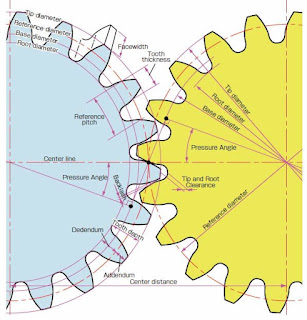Hi, There are many times we do not know the little things and must have the Passion and Desire to know them. Today I'm going to tell you a little bit about Mechanical Information.
Hope you like it and find it useful
Hope you like it and find it useful
 |
GEAR TERMINOLOGY
|
The face of the tooth: the tooth layer is known as the face beyond the pitch circle.
The tooth flank: The tooth's surface is known as flank under the pitch circle.
Top ground: The increasing tooth surface is known as the top surface.
Face width: tooth width is related to as face width.
Face width: tooth width is related to as face width.
Pitch Circle: It's an imaginary disk this is just spinning. By the pitch circle movement the gear movement is described.
Pitch Ring diameter: The pitch ring diameter of the center of the gear is related to as the circle diameter of the pitch. The diameter of the gear is described by the diameter of its rim.
 |
| GEAR TERMINOLOGY |
Pitch point: When both gears are in
contact, the point in general for both meshing gear pitch circles is called the
pitch point.
Pressure angle of obliquity angle: pressure angle
is the angle from the usual normal to the pitch circle to the usual tangent.
Addendum: Distance in the radial direction between
the pitch circle and the tooth top is referred to as an additional.
Dedendum: The distance from the pitch circle in
radial directions to the bottom of the tooth is called the gear's dedendum.
Addendum circle: the circle is called the
circle of the addendum from the top of the lip. The circle with the pitch
circle is focused.
Dedendum Circle: The circle is known as the dedendum
circle, starting from the base of the tooth. This circle is often combined with
a range of pitches and addenda.
Circular pitch: the distance measuring along the diameter of
the pitch circle between the point of the tooth and the point of the adjacent
tooth is known as the circulatory pitch. This plays a significant function in
the meshing of machinery. If they have the same circular pitch, two gears will
mesh correctly together.
Diametric pitch: The ratio of the number of teeth
to the pitch circle diameter in millimeters is called a diametric pitch.
Module: The pitch circle diameter ratio in
millimeters is known as a piece for the total number of teeth. The diametric
pitch is identical.
Clearance: If the two gears are mesh, the radial
distance from one gear's top to the lower tooth of another gear is called
clearance. Clearance: Clearance. The circle is defined as the angle of
clearance from the tip of the tooth.
Maximum depth: The overall depth is defined as the
sum of addendum and dedendum of the gear. The distance to the measurement of
the dedendum circle between addendum circles is radial.
Working depth: The distance from the additional
circle to the clearance circuit is defined as the working depth of the
equipment.
The density of the tooth: The density of the tooth
is defined as dental thickness around the diameter of the rim.
A gap of the tooth: The gap between the two
neighboring teeth is known as the space of the tooth.
Backlash: the discrepancy is between the width of
the gum and the bone. That is the discrepancy. The jamming of equipment in a
meshing state is prevented.
Profile: the curved one is known as the tooth
profile, shaped by the face and the flank. The tooth of the gears is normally
cycloidal or involute.
Contact Path: The curved line followed by the
contact point of the two-shaped teeth beginning at the end is known as the
contact patch.
Ark of contact: the curve traced from the pitch
point is called the arc of touch from the start to the end of the engagement.
Arc of approach: The section of the path from the
start of the pitch to the pitch is known as the Arc of approach.
Arc of recess: The section of the journey to the
end of the engagement is known as the arc of the pitch.
I hope you find the above information helpful. This is how the Mechanical Information will get you on my blog. I'm sure you'll like it. Feel free to leave your feedback.
Thank you for reading.
Post a Comment